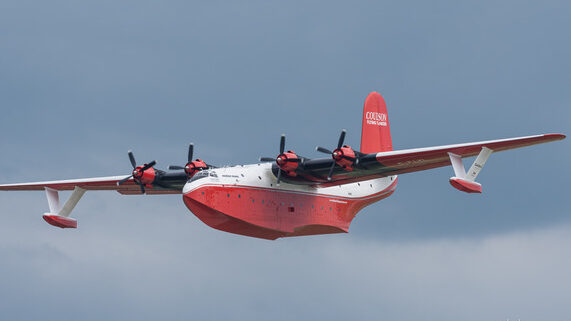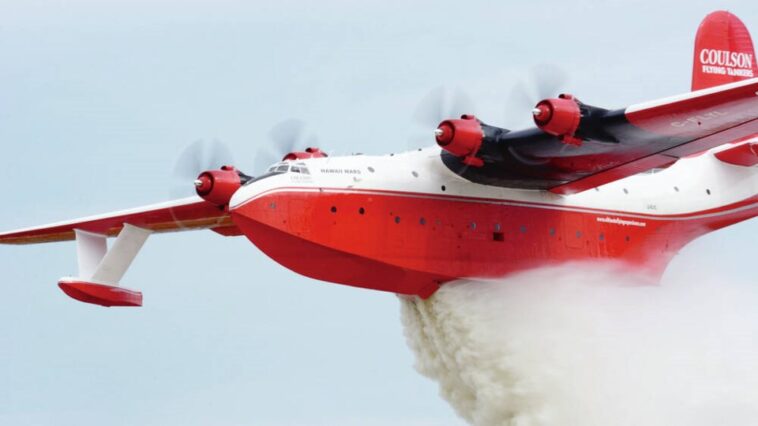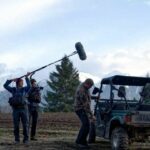When talk turns to wildfires, in any BC cafe, pub or on social media, you can bet someone will toast the Martin Mars – then lament that BC’s famous planes are no longer in the skies dousing flames.
The giant “flying boats” are the size of a Boeing 747 jetliner with a 200-foot wingspan, and were used from 1961 to 2015 to fight more than 4,000 wildfires. The last two of their kind were retired from service in 2015.
Now, the British Columbia Aviation Museum announced that it will turn the red and white Hawaii Mars into the centrepiece of a new water-bomber exhibit in a new hangar at Victoria International Airport.
The plane was donated to the museum by owner Wayne Coulson of Coulson Aviation, while the province announced a $250,000 grant for the project.
Six Mars aircraft were designed and built during World War II by the US Navy to transport troops over the Pacific. Two were destroyed, and then in 1959, the four remaining planes were sold off for scrap.
“While able to extinguish some fires with a single pass, the huge, radial engine aircraft require large lakes for loading and are at a disadvantage in mountainous terrain. The evolution of aviation and firefighting technology and techniques limited the deployment of the Mars, and after five decades of firefighting, they were retired in 2015.”
British Columbia Aviation Museum
But instead of being junked, the planes were scooped up by BC forestry companies, converted to tankers, and used for firefighting. One was wrecked in a crash, and a typhoon destroyed a second one, but for about five decades, the last two–Hawaii Mars and Philippine Mars–roamed BC’s skies and captured our imaginations.
“While able to extinguish some fires with a single pass, the huge, radial engine aircraft require large lakes for loading and are at a disadvantage in mountainous terrain. The evolution of aviation and firefighting technology and techniques limited the deployment of the Mars, and after five decades of firefighting, they were retired in 2015,” said the museum.
“When those four 2,400 HP Wright R3350-24WA engines turning 16-foot props were fired up, they always drew a crowd.”
British Columbia Aviation Museum
They have been retired for nearly a decade, but plenty of people still want to see them. “When those four 2,400 HP Wright R3350-24WA engines turning 16-foot props were fired up, they always drew a crowd,” said the BC Aviation Museum.

Many commenters on social media were not happy the beloved plane will become a museum piece.
“Put them back to work!!” said commenter Andy Smith. “Too bad that they can’t be put back in service. It’s pitiful watching a fire being splashed with a bit of water from a helicopter,” added Gary Kessler.
In a recent post about BC’s historic drought and the risk of another historic fire season, commenter Rob Smith wrote, “So let me get this straight. We are pretty sure that BC is going to burn yet again this summer. And still, planes like the Martin Mars, the very best firefighting aircraft in the world still sit unused. So, when does this become criminal?”
“The Mars arrival is going to be like a big blockbuster movie weekend as everyone from Nanaimo to Victoria will get to watch the massive, majestic Hawaii fly low and slow overhead with its immense 200-foot wingspan and wonderfully loud radial engines.”
Richard Mosdell, project lead for the Save the Mars Team
Coulson Aviation is now readying the Hawaii Martin Mars to fly again from its base in Sproat Lake, said the museum. At a date to be announced this year, the giant airboat will fly one last victory lap over Vancouver Island to land in the ocean at Pat Bay, then be hauled onto land near the Coast Guard base before being shipped to its last resting place, near Victoria Airport.
“The Mars arrival is going to be like a big blockbuster movie weekend as everyone from Nanaimo to Victoria will get to watch the massive, majestic Hawaii fly low and slow overhead with its immense 200-foot wingspan and wonderfully loud radial engines,” said Richard Mosdell, project lead for the Save the Mars Team.




